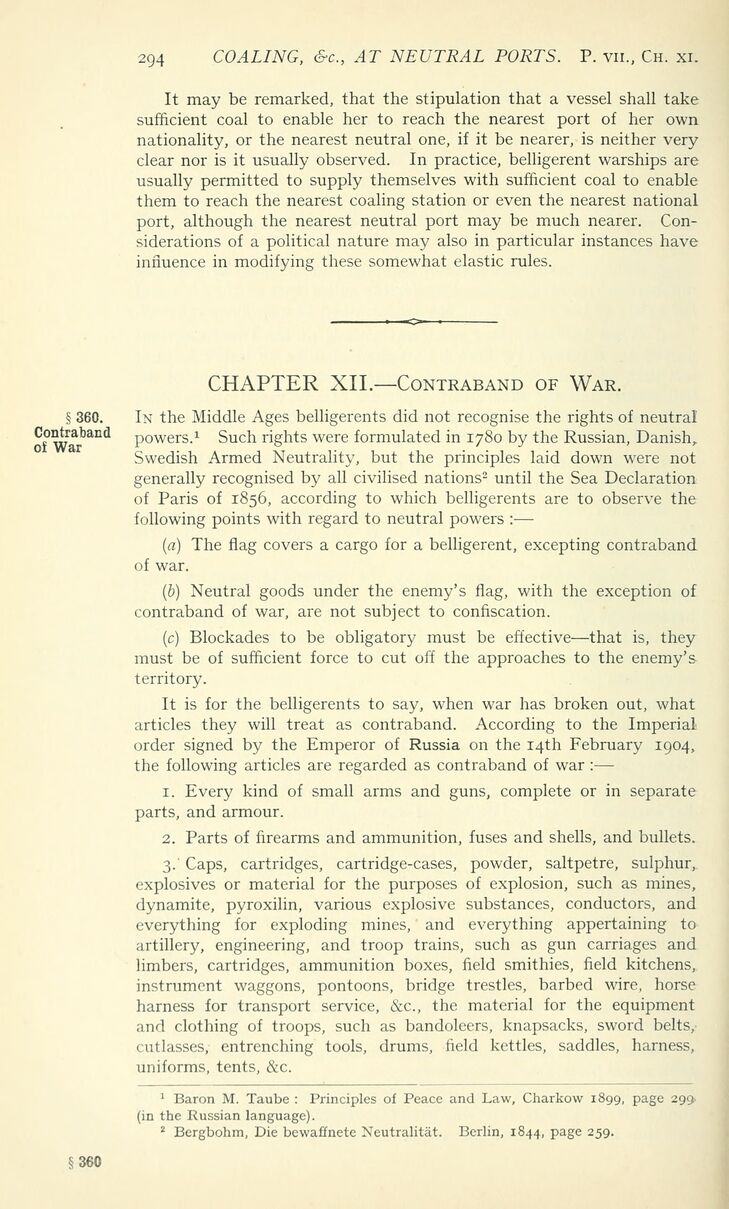
Full resolution (JPEG) - On this page / på denna sida - Pages ...

<< prev. page << föreg. sida << >> nästa sida >> next page >>
Below is the raw OCR text
from the above scanned image.
Do you see an error? Proofread the page now!
Här nedan syns maskintolkade texten från faksimilbilden ovan.
Ser du något fel? Korrekturläs sidan nu!
This page has never been proofread. / Denna sida har aldrig korrekturlästs.
COALING, &cAT NEUTRAL PORTS. P. vii., Сн. xi.
It may be remarked, that the stipulation that a vessel shall take
sufficient coal to enable her to reach the nearest port of her own
nationality, or the nearest neutral one, if it be nearer, is neither very
clear nor is it usually observed. In practice, belligerent warships are
usually permitted to supply themselves with sufficient coal to enable
them to reach the nearest coaling station or even the nearest national
port, although the nearest neutral port may be much nearer.
Considerations of a political nature may also in particular instances have
influence in modifying these somewhat elastic rules.
CHAPTER XII.—Contraband of War.
In the Middle Ages belligerents did not recognise the rights of neutral
powers.1 Such rights were formulated in 1780 by the Russian, Danish,
Swedish Armed Neutrality, but the principles laid down were not
generally recognised by all civilised nations2 until the Sea Declaration
of Paris of 1856, according to which belligerents are to observe the
following points with regard to neutral powers :—
(a) The flag covers a cargo for a belligerent, excepting contraband
of war.
(b) Neutral goods under the enemy’s flag, with the exception of
contraband of war, are not subject to confiscation.
(c) Blockades to be obligatory must be effective—that is, they
must be of sufficient force to cut off the approaches to the enemy’s
territory.
It is for the belligerents to say, when war has broken out, what
articles they will treat as contraband. According to the Imperial
order signed by the Emperor of Russia on the 14th February 1904,
the following articles are regarded as contraband of war :—
1. Every kind of small arms and guns, complete or in separate
parts, and armour.
2. Parts of firearms and ammunition, fuses and shells, and bullets.
3.’ Caps, cartridges, cartridge-cases, powder, saltpetre, sulphur,
explosives or material for the purposes of explosion, such as mines,
dynamite, pyroxilin, various explosive substances, conductors, and
everything for exploding mines, and everything appertaining to
artillery, engineering, and troop trains, such as gun carriages and
limbers, cartridges, ammunition boxes, field smithies, field kitchens,
instrument waggons, pontoons, bridge trestles, barbed wire, horse
harness for transport service, &c., the material for the equipment
and clothing of troops, such as bandoleers, knapsacks, sword belts,
cutlasses, entrenching tools, drums, field kettles, saddles, harness,
uniforms, tents, &c.
1 Baron M. Taube : Principles of Peace and Law, Charkow 1899, page 299.
(in the Russian language).
2 Bergbohm, Die bewaffnete Neutralitat. Berlin, 1844, page 259.
§ 360
§ 360.
Contraband
of War
<< prev. page << föreg. sida << >> nästa sida >> next page >>